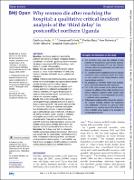| dc.contributor.author | Alobo, Gasthony | |
| dc.contributor.author | Ochola, Emmanuel | |
| dc.contributor.author | Bayo, Pontius | |
| dc.contributor.author | Muhereza, Alex | |
| dc.contributor.author | Nahurira, Violah | |
| dc.contributor.author | Byamugisha, Josaphat | |
| dc.date.accessioned | 2021-04-02T20:06:03Z | |
| dc.date.available | 2021-04-02T20:06:03Z | |
| dc.date.issued | 2021 | |
| dc.identifier.citation | Alobo, G., Ochola, E., Bayo, P., Muhereza, A., Nahurira, V., & Byamugisha, J. (2021). Why women die after reaching the hospital: a qualitative critical incident analysis of the ‘third delay’in postconflict northern Uganda. BMJ open, 11(3), e042909. | en_US |
| dc.identifier.uri | http:// dx. doi. org/ 10. 1136/ bmjopen- 2020- 042909. | |
| dc.identifier.uri | https://hdl.handle.net/123456789/228 | |
| dc.description.abstract | Objectives To critically explore and describe the
pathways that women who require emergency obstetrics
and newborn care (EmONC) go through and to understand
the delays in accessing EmONC after reaching a health
facility in a conflict-affected
setting.
Design This was a qualitative study with two units of
analysis: (1) critical incident technique (CIT) and (2) key
informant interviews with health workers, patients and
attendants.
Setting Thirteen primary healthcare centres, one general
private-not-
for-
profit
hospital, one regional referral hospital
and one teaching hospital in northern Uganda.
Participants Forty-nine
purposively selected health
workers, patients and attendants participated in key
informant interviews. CIT mapped the pathways for
maternal deaths and near-misses
selected based on
critical case purposive sampling.
Results After reaching the health facility, a pregnant
woman goes through a complex pathway that leads to
delays in receiving EmONC. Five reasons were identified
for these delays: shortage of medicines and supplies,
lack of blood and functionality of operating theatres,
gaps in staff coverage, gaps in staff skills, and delays in
the interfacility referral system. Shortage of medicines
and supplies was central in most of the pathways,
characterised by three patterns: delay to treat, back-and-
forth
movements to buy medicines or supplies, and
multiple referrals across facilities. Some women also
bypassed facilities they deemed to be non-functional.
Conclusion Our findings show that the pathway to
EmONC is precarious and takes too long even after making
early contact with the health facility. Improvement of skills,
better management of the meagre human resource and
availing essential medical supplies in health facilities may
help to reduce the gaps in a facility’s emergency readiness
and thus improve maternal and neonatal outcomes. | en_US |
| dc.language.iso | en | en_US |
| dc.publisher | BMJ open | en_US |
| dc.subject | Hospital | en_US |
| dc.subject | Third delay | en_US |
| dc.subject | Northern Uganda | en_US |
| dc.subject | Delivery | en_US |
| dc.title | Why women die after reaching the hospital: a qualitative critical incident analysis of the ‘third delay’ in postconflict northern Uganda | en_US |
| dc.type | Article | en_US |

